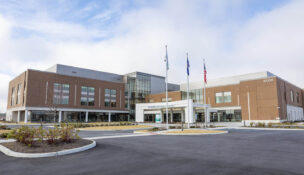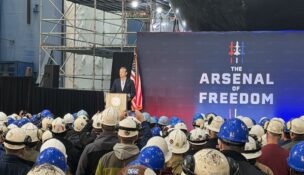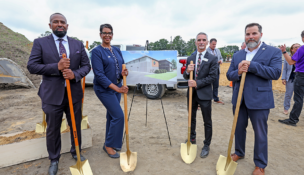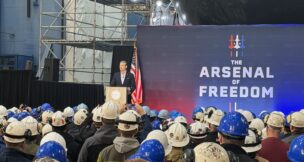Harder, better, faster, stronger
A century after start, aircraft carrier business advances
Harder, better, faster, stronger
A century after start, aircraft carrier business advances
On March 20, 1922, the U.S. Navy commissioned its first aircraft carrier: the USS Langley.
A century later, the Navy is hosting centennial events around the country, including in Norfolk, where the USS Langley was converted into the Navy’s first carrier from the USS Jupiter, the Navy’s first electrically propelled ship. The Jupiter was decommissioned in Hampton Roads in 1920, and workers at the Norfolk Navy Yard worked on it for two years, leading to its recommissioning as the Langley.
Today, the aircraft carrier business is a much bigger deal in Hampton Roads, where Huntington Ingalls Industries‘ Newport News Shipbuilding (NNS) division, which began building carriers in 1934, is the country’s only nuclear-powered aircraft carrier builder and the state’s largest industrial employer.
“The business environment, the industrial base and the workforce are all absolutely vital to our ability to operate and continue to maintain our ships,” says Rear Adm. John F. Meier, commander of Naval Air Force Atlantic. “We literally could not do it without the Hampton Roads area.”
Aircraft carriers “revolutionized combat at sea,” playing a major role in World War II, says retired Rear Adm. Craig Quigley, executive director of the Hampton Roads Military and Federal Facilities Alliance.
Today, NNS is working on the next generation of carriers. The nuclear-powered Gerald R. Ford-class includes four flattops planned for delivery to the Navy by 2023.
The Ford-class is a dramatic advance from the aging 10-ship Nimitz-class, the first of which was commissioned in 1975. Among the 23 new technologies on the Ford-class carriers are Electromagnetic Aircraft Launch Systems (EMALS) — replacing steam-driven systems — and electric elevators, which require less maintenance than the hydraulic ones they’re superseding. EMALs allow for better control and put less stress on aircraft, says Brian Fields, NNS’ vice president of aircraft carrier construction. Upgraded electromagnetic weapons elevators are expected to move ordnance through the ship more efficiently, helping it achieve its mission of launching and recovering aircraft faster.
Ford-class carriers are designed to dock for maintenance less frequently, Fields says, and will require about 600 fewer sailors than the Nimitz-class carriers. Over a Ford-class carrier‘s 50-year lifespan, the Navy estimates it will spend $4 billion less per ship than on a Nimitz-class carrier, thanks to reduced maintenance and crew member requirements.
The first ship in this class, the USS Gerald R. Ford, has been delivered to the Navy, with its maiden deployment expected this fall. The Navy originally estimated the Ford would cost about $10.49 billion, but the ship’s cost escalated to $13.3 billion, making it the most expensive Navy ship built to date.
The Ford’s keel-laying ceremony —similar to a construction site’s ground-breaking — took place in 2009, when NNS was Northrop Grumman Shipbuilding. NNS delivered the Ford to the Navy in 2017, two years later than targeted, and then-President Donald Trump commissioned it in July 2017, although it still required more work before deployment.
Each new major technology system on the Ford came with its own challenges, says Meier, who was the Ford’s first commanding officer. “If there’s a lesson learned here,” he says, “it’s probably you don’t want to put that much new technology on a ship at a single time.”
In March, NNS announced it had finished a six-month maintenance period on the Ford. “We’re really proud of her and what she’s going to be able to do for the Navy,” Fields says.
Meanwhile, the next Ford-class carrier, the USS John F. Kennedy, has about two years’ more work to go before its delivery, Fields says. The ship is in the process of being turned over to the Navy.
Along with the Kennedy, two Nimitz-class carriers are at NNS: the USS George Washington and the USS John C. Stennis are at the shipyard for their midlife refueling and complex overhaul. NNS is the only shipyard that performs that work, a process that costs billions of dollars and takes several years to complete.
The Navy completed a double-ship buy for the third and fourth Ford-class carriers — the USS Enterprise and the USS Doris Miller — which allows for quicker and less expensive builds. NNS is working with the Navy and the ship’s sponsors — U.S. Olympians Simone Biles and Katie Ledecky — to find a date this year for the Enterprise’s keel-laying ceremony. (Traditionally women, ship’s sponsors perform ceremonial duties for a ship, including smashing a bottle on its bow during the ship’s christening.)
The USS Doris Miller, named for the first Black American awarded the Navy Cross after he was killed in action during World War II, is in the initial stages of construction but, thanks to the block purchase, her design and parts procurement has advanced, Fields says. Currently, NNS is building structural pieces for the craft.
More than 31,000 people in Virginia work on aircraft carriers or in indirect jobs related to the industry, and 403 businesses in the state supply carrier parts, according to the Aircraft Carrier Industrial Base Coalition. NNS employs about 25,000 people total, and approximately 8,000 hourly workers are assigned to new carrier construction and Nimitz-class overhauls.
“It’s kind of a part of our DNA, of who we are as a region,” Quigley says. “We’re very proud of our wide and deep association with the Navy in Hampton Roads, and to be the only producer in the nation of nuclear-powered aircraft carriers is something the region is very proud of.”
C















